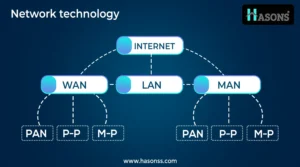Network Technology
Telecommunication network technology is one of the most important pillars of the present society, with the primary role of linking a variety of gadgets and individuals from distinct parts of the globe. In this piece of the blog, I will making with an explanation of the various types of networks that make this possible. Under our content section, we will start with network types diagram where we have categorized the types of social networks and their roles indicated on the diagram.
We will then move to the visual presentation of network types to ensure that the understanding is clear to anyone involved. Last but not least, we will provide a detailed view of cloud network technologies as well as how this type of network has transmuted the manner in which the data is connected and stored. When you are through reading this blog post, I believe and hope that you stand to enhance your knowledge as well as understanding of the network technology intertwined web.
Computer networking is all about how individual computers and devices can compute and communicate with each other over a network. It examines equipment requirements such as the physical media used and the communication protocols required in exchange of info. This field comprises of small-network geographical areas (LANs) and large geographical area networks (WANs and the internet). This technology focuses on network formation for the contemporary trends in communication and collaboration.

Definition of Network Technology
This refers to a connection of devices that enables them to exchange data and interact. It has been comprised of cables, routers, and switches. This also entails program and procedures that dictate how data flows from one point to another. We are all grateful to the network technology through which devices at any location can exchange information. It also means that if they share the same resources or can collaborate at all without being in the same physical location. An end-to-end and efficient working network is important for groups or companies. First of all they should be safe, also they should be fast and reliable. In simple words, the central part of network technology is these parts – like cards in devices, modems, and points to get wires.
There is also boot, as well as certain protocols for data transmission and receipt. How these parts work in detail and link with each other really matters. They determine the efficiency of the network and its capabilities of growth and development. Procedures such as TCP/IP, are the ‘languages’the devices employ in network communications. It established how data is transmitted or delivered, how problems encountered in data transmission are solved among others.
These rules are beneficial in a way that devices produced by different makers can communicate just perfectly well. Then, there is the gear that organizes the network physically – routers, switches, hubs and other machinery. It is noteworthy that making this gear function cohesively and efficiently is a great achievement. It ensures the network is dependable, optimized, and protected..
Experiencing Low WiFi Quality
Low WiFi Quality This is one of the most frequent complaints many people have to make these days. This can really ruin your work or your fun time. It is usually common due to signal interferences from objects like walls or multiple devices connecting to the same network. This could be due to old or not-so-great WiFi devices or not setting up your network the best way.
Here are some solutions that you can use to remedy the situation:
It may help to move the WiFi box by strengthening the signal. Reducing how many devices connect can help as well also. Switching to a new type of WiFi could also improve your wifi signal strength and general wifi quality. Adjusting your network settings can also be of great help. Hacks such as choosing the right “channel” or flipping on appliances to reduce signal disruption can make your internet more consistent.
That is why working on these issues is important in order to keep the network prepared for all you do in the Internet. It is important to work on improving low wifi quality. This makes a lot of difference in terms of how effectively the devices can connect and how seamlessly the devices are able to operate on the Internet. Consequently, the right procedures will make your network improved. And that means a better and faster wireless Web for all of us.
Network Technologies
Network Technologies refers to many devices and technologies. They facilitate communication between computers and the devices. Some include: Computer Networks: LANs, WANs, wireless networks, and the Internet: Different computer networks offer different connectivity solutions and have varying sizes.
• Network Devices: Network equipment such as routers, switches, bridges and access points assist in the forwarding of data and traffic control respectively. They are very crucial in ensuring that networks perform optimally.
• Network Protocols: TCP/IP, HTTP, FTP, SMTP and many others define how data will be exchanged between devices and applications.
• Cloud Networking: Cloud computing introduced new technologies such as SDN and cloud deployment models. These allow networks to be managed more easily, expand when necessary, and can be centralized..
• VPN Technology: VPNs improve the security of Internet connections by creating encrypted paths. They help in managing data as it passes through various remote systems, devices, and organizational networks.
These are the key technologies that define today’s global digital network as a whole. They enable the way we talk, collaborate, and disseminate knowledge throughout the globe.
Hierarchical Structure of Network Types
We use many networks technology to communicate and share data in the modern world. This is because they form a major and intertwined structure that connects the whole world. This large network is made up of internet, which links all the other small networks and gadgets together across the world.
Deeper analysis shows several different network types in the analyzed Global Internet. All three have their own roles and operate in different spheres. For instance, there are LANs that operate within a single building or campus while WANs span cities or countries, probably comprising several LANs. MANs span across cities while PANs assist devices around a certain person to connect.
Similarly, the different network types also have their own set of regulations. These rules include the network architecture, network standards and lastly the network protocols. They regulate the traffic of information and ensure all the segments in the network are operational. Such an organized system facilitates networks function effectively, whether they are a small personal coordinated network or the large Internet. It satisfies people, groups, and the larger world or global society.
Understanding the Networks type Diagram
A network type diagram is one of the network diagrams that seek to show the different networks that exist in the computer technology realm. This helps us learn about various options for connecting devices and computers and how those interconnected devices communicate.
The three principal forms of networks illustrated in this diagram include LAN, WAN, and MAN which are abbreviations of Local Area Network, Wide Area Network, and Metropolitan Area Network, respectively.
These include LAN where devices are grouped in a small area with small coverage while WAN is where devices are connected vice versa with large geographical coverage. This information helps businesses, organizations, and individuals choose the most optimum network for their use. Therefore, I believe that, by using this visualization, one can see how important networking technology is in maintaining the current standards of living.
Visualizing network types
Telecommunication is a vital component of the contemporary society, enabling the communication of people and devices regardless of a vast distance. Computing networks come in many different forms and they are classified based on the function, capacity, geography, and accessibility. The primary network type is the Local Area Network, which interconnects devices within a limited geographical location, typically a building or several buildings.
Local Area Networks (LANs) cover a smaller area and can be restricted to just a single city or country. VPNs are facilitating secure connection over public networks where users can connect to private network from remote location. MANs are utilized to interconnect several LANs within a single metropolitan city area. Last but not the least, Internet is the biggest and most commonly used network joining million of computers and devices across the world.

Delving into cloud Network Technology Cloud network technology has helped shape the face of the interactively connected society in the age of IoT. It is an extremely efficient, portable and inexpensive means for any company wishing to improve its business. Cloud networks entail data storage and retrieval via the internet unlike LAN and WAN which use physical servers hence a lot of flexibility . This technology also has no requirements in physical infrastructure and thus also does not require personnel to maintain them. From Hybrid to multi cloud there are numerous flavors to choose depending on business needs. With an increasing number of organizations adopting work from home policies as well as operating businesses going digital, exploring more about the cloud network technology has become an exigency of today’s world.
Conclusion
Nevertheless, as people become more connected the issue of security as a safeguard against cybercrime becomes an imperative consideration. While expanding the possibilities offered by network technology, we must emphasize the importance of considering ethical aspects and using the technology for the common good. In conclusion, network technology has enhanced the quality of our lives and will keep on changing the course of humanity in so many ways.
| If you are reading Network Technology then also check our other blogs: | |
| Characteristics of cloud computing | Device Management In Operating System |
| Importance of Internet of Things (IoT) | Tree Topology in Computer Networks |
Network Technology
- What are the different types of computer networks?
Network Type Description Example Local Area Network Connects devices within a limited geographical area, such as an office or school building. Office LAN, School LAN Wide Area Network Spans over a large geographical area, connecting multiple LANs and covering extensive regions. Internet, Global WAN Metropolitan Area Network Covers a city or metropolitan area, providing connectivity to various institutions and businesses. City-wide internet infrastructure, Campus-wide network Personal Area Network Links personal devices together, facilitating communication and data sharing on an individual level. Bluetooth network between smartphone, tablet, and laptop Virtual Private Network Enables remote access to a private network over the internet, ensuring secure communication and data transfer. Corporate VPN, Remote access to a home network - What is a router?A router is a highly specialized gadget that is indispensable in the performance of computer networks. It is an entity that can interconnect different machines, computers, printers, mobile phones and other gadgets to create a network.
- What is cloud networking?Cloud networking is defined as the utilization of cloud computing platforms to control and use network assets on the Internet, which holds further adaptability, versatility, and reasonable nature.
- What is a VPN?A VPN is a means by which a user can form a secure connection to a private network by connecting through the public network in a secure way that encrypts the data being transferred.
